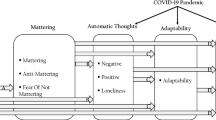Abstract
The study examined the relationship between the Type A behavior pattern and personality hardiness and predicted an interaction between the two that would be influential for illness onset. Type A and hardiness were found to be conceptually different and empirically independent factors. Under high stressful life events, male executives who were high in Type A and low in hardiness tended toward higher general illness scores than any other executives. Type A and hardiness emerge from this study as bases for extrinsic and intrinsic motivation, respectively.
Similar content being viewed by others
References
Cobb, S. (1976). Social support as a moderator of life stress.Psychosom. Med. 38: 300–314.
Cooper, T., Detre, T., and Weiss, S. M. (1981). Coronary-prone behavior and coronary heart disease: A critical review.Circulation 63: 1199–1215.
Dohrenwend, B. S., and Dohrenwend, B. P. (1974).Stressful Life Events: Their Nature and Effects, Wiley, New York.
Dohrenwend, B. S., Krasnoff, L., Askenasy, A. R., and Dohrenwend, B. P. (1978). Exemplification of a method for scaling life events: The PERI Life-Events Scale.J. Health Soc. Behav. 19: 205–229.
Friedman, M. (1969).Pathogenesis of Coronary Artery Disease, McGraw-Hill, New York.
Friedman, M., and Rosenman, R. H. (1974).Type A Behavior and Your Heart, Fawcett, Greenwich, Conn.
Glass, D. C. (1977).Behavior Patterns, Stress, and Coronary Disease, Wiley New York.
Hahn, M. E. (1966).California Life Goals Evaluation Schedule, Western Psychological Services, Palo Alto, Calif.
Holmes, T. H., and Rahe, R. H. (1967). The Social Readjustment Rating Scale.J. Psychosom. Res. 11: 213–218.
Howard, J. H., Rechnitzer, P. A., and Cunningham, D. A. (1975). Coping with job tension.Publ. Personnel Manage. 4: 317–326.
Jenkins, C. D., Rosenman, R. H., and Friedman, M. (1967). Development of an objective psychological test for the determination of the coronary-prone patterns in employed men.J. Chron. Dis. 20: 371–379.
Jenkins, C. D., Zyganski, S. J., and Rosenman, R. H. (1979).Jenkins Activity Survey, Psychological Corp., New York.
Kobasa, S. C. (1979). Stressful life events, personality and health: An inquiry into hardiness.J. Personal. Soc. Psychol. 37: 1–11.
Kobasa, S. C., and Puccetti, M. C. (1983). Personality and social resources in stress-resistance.J. Personal. Soc. Psychol. (in press).
Kobasa, S. C., Hilker, R. R. J., Jr., and Maddi, S. R. (1979). Who stays healthy under stress?J. Occupation. Med. 21: 595–598.
Kobasa, S. C., Maddi, S. R., and Courington, S. (1981). Personality and constitution as mediators in the stress-illness relationship.J. Health Soc. Behav. 22: 368–378.
Kobasa, S. C., Maddi, S. R., and Kahn, S. (1982a). Hardiness and health: A prospective study.J. Personal. Soc. Psychol. 42: 168–177.
Kobasa, S. C., Maddi, S. R., and Puccetti, M. C. (1982b). Personality and exercise as buffers in the stress-illness relationship.J. Behav. Med. 5: 391–404.
Maddi, S. R., and Kobasa, S. C. (1981). Intrinsic motivation and health. In Day, H. I. (ed.),Advances in Intrinsic Motivation and Aesthetics, Plenum, New York.
Maddi, S. R., Kobasa, S. C., and Hoover, M. (1979). An alienation test.J. Human. Psychol. 19: 73–76.
Matthews, K. A. (1982). Psychological perspectives on the Type A behavior pattern.Psychol. Bull. 91: 293–323.
McClelland, D. C. (1961).The Achieving Society, Van Nostrand, Princeton, N.J.
Mechanic, D. (1962). The concept of illness behavior.J. Chron. Dis. 15: 189–194.
Mettlin, C. (1976). Occupational careers and the prevention of coronary-prone behavior.Soc. Sci. Med. 10: 367–372.
Paffenberger, R. S., Jr., Wing, A. L., and Hyde, R. T. (1978). Physical activity as an index of heart attack risk in college alumni.Am. J. Epidemiol. 108: 161–175.
Rosenman, R. H., Brand, R. J., Sholtz, R. I., and Friedman, M. (1976). Multivariate prediction of coronary heart disease during 8.5 year follow-up in the Western Collaborative Group study.Am. J. Cardiol. 37: 903–910.
Rotter, J. B., Seeman, M., and Liverant, S. (1962). Internal vs. external locus of control of reinforcement: A major variable in behavior study. In Washburne, N. F. (ed.),Decisions, Values, and Groups, Pergamon, London.
Schlegel, R. P., Wellwood, J. K., Copps, B. E., Gruchow, W. H., and Sharratt, M. T. (1980). The relationship between perceived challenge and daily symptom reporting in Type A vs. Type B postinfarct subjects.J. Behav. Med. 3: 191–204.
Sparacino, J. (1979). The Type A behavior pattern: A critical assessment.J. Hum. Stress 21: 37–51.
Twaddle, A. C. (1979).Sickness Behavior and the Sick Role, G. K. Hall, Boston.
Waldron, I. (1978). The coronary-prone behavior pattern, blood pressure, employment and socio-economic status in women.J. Psychosom. Res. 22: 79–87.
Waldron, I., Zyzanski, S., Shekelle, R. B., Jenkins, C. D., and Tannenbaum, S. (1977). The coronary-prone behavior pattern in employed men and women.J. Hum. Stress 3: 2–18.
Wyler, A. R., Masuda, M., and Holmes, T. H. (1968). Seriousness of Illness Rating Scale.J. Psychosom. Res. 11: 363–375.
Author information
Authors and Affiliations
Additional information
This work was supported in whole by NIMH Grant MH 28839 to Kobasa and Maddi. We wish to thank Robert R. Hilker, Jr., James Kennedy, Lorill Brown-Rezanka, Christine Hinze, and Mark C. Puccetti for their indispensable help.
Rights and permissions
About this article
Cite this article
Kobasa, S.C., Maddi, S.R. & Zola, M.A. Type A and hardiness. J Behav Med 6, 41–51 (1983). https://doi.org/10.1007/BF00845275
Accepted:
Issue Date:
DOI: https://doi.org/10.1007/BF00845275



